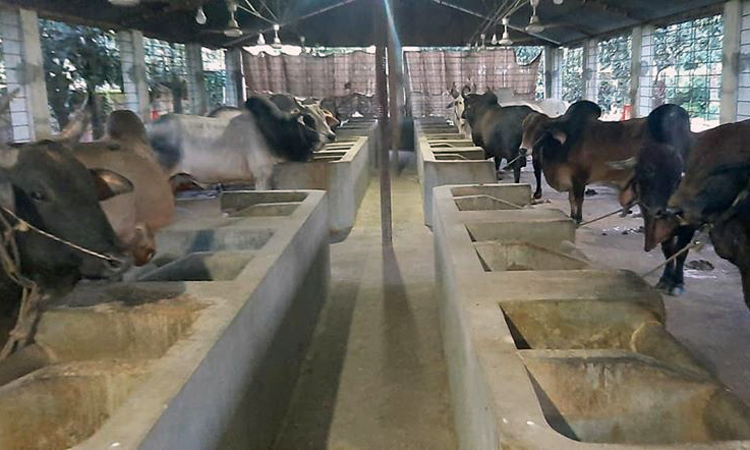News Flash
News Flash

By Md Aynal Haque
RAJSHAHI, April 30, 2025 (BSS) - Like the previous years, beef fattening activities have become vibrant in the region as the villagers attain lucrative profit from the venture ahead of the upcoming Eid-ul-Azha.
This type of house to house beef fattening has been contributing a lot towards improving living and livelihood conditions of the grassroots population through enriching animal resources for the last couple of decades.
The business has brightened the prospects of exporting beef to different areas within the country after meeting the local demands. Moreover, the boosted native cattle production has made the region self-reliant in cattle production.
For the last couple of years, the buyers were seen opting to purchase native animals in most of the cattle markets.
Dr Ananda Kumar Adhikery, Divisional Director of Department of Livestock Services, told BSS that the local animal husbandry sector has marked a revolutionary boost in recent years bringing fortune to hundreds of people in the region.
He said many of the rural families have been rearing and fattening bulls commercially and earning huge profits every year. Some of the poor and marginalized people including women have achieved tremendous successes in the sector.
Currently, the cattle markets are witnessing a record supply of domestic animals following a huge boost in the local animal husbandry sector in recent years.
Meanwhile, for the last couple of years, many villagers have been seen fattening their bulls using natural methods.
They use only straw, molasses, oilcake, gram, black-gram, green grass and wheat bran as feed instead of any steroid tablet or injection.
"I, myself, prepare straw, grass and other fodders and wash her fattening cattles regularly," said Mabiya Khatun, 45 in her semi-pucca house in Halidagachhi village under Charghat upazila in Rajshahi.
Her neighbour Abdus Sattar, 53, having four bulls, narrated his success story of the business. At least 43 other families of the locality are fattening cattle including bulls to catch the lucrative sacrificial cattle market.
"We see an income-generation atmosphere in the village over the bull fattening," he added.
Already, they have replaced their traditional domestic cattle-rearing process with modern and commercially potential ones.
They become habituated to various money transactions including borrowing loans from different public and private commercial banks for purchasing bulls alongside repaying those in due time.
There are more than 250 beef fattening farms only in Durgapur and Puthiya Upazilas in the district where the farmers are fattening around 10,000 bulls using the natural method.
Besides, the villagers are also rearing over 25,000 goats in a hygienic manner.
Dr Ananda Adhikery termed the practice as a positive sign for sound public health saying the department of livestock has been extending necessary support towards the farmers in this regard.
"We are discouraging the businessmen and farmers using harmful medicines including hormones and steroids to fatten cattle to make immediate profit by selling fat animals for sacrifice," he added.
Tozammel Haque, a bull fattening farm owner of Nandigram village, said the farmers have adopted new and improved practices and technologies in bull rearing and fattening contributing to enhanced production and productivity.
The size of the market has expanded due to the growing active role of large and small-scale private companies.
Line agencies have become proactive towards supporting market actors especially local service providers (LSPs) by dint of their complementary roles in extension services.
In practice, the LSPs provide training, advice and input to the producers and earn on an average Tk 4,500 per month. Routinely, they extend different modern technology to the producers through setting demonstrations in the locality.
Sharing his expertise Prof Jalal Uddin Sarder of the Department of Veterinary and Animal Sciences at Rajshahi University said beef fattening ventures have proven successful in Rajshahi, providing a boost to rural livelihoods and the local economy.
Many farmers, including marginalized individuals and women, have embraced this practice, turning it into a profitable and sustainable income source.
This has been facilitated by access to modern technologies, training and support from organizations like the Department of Livestock Services.